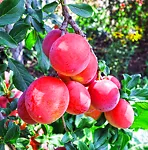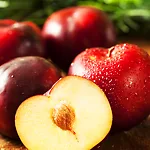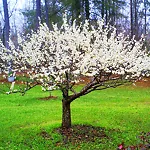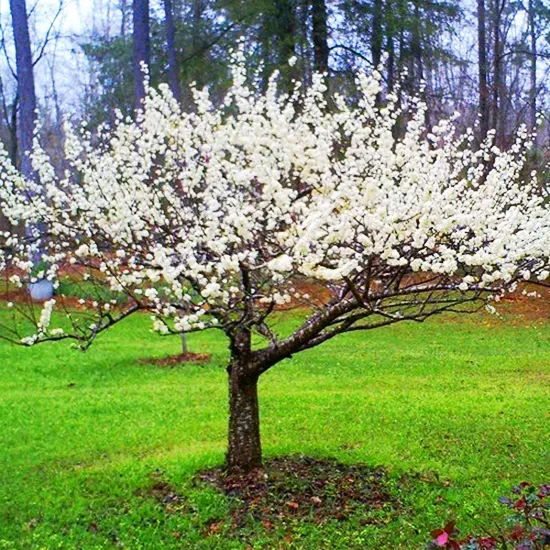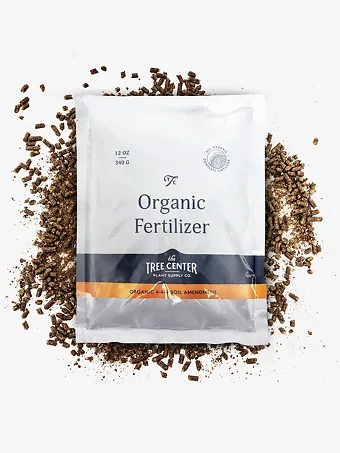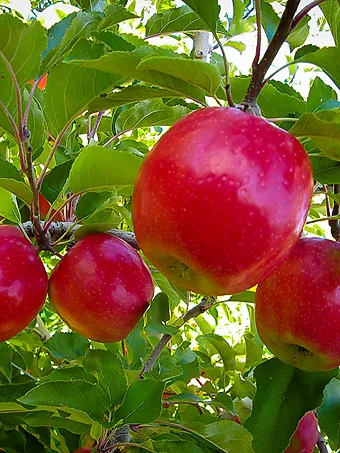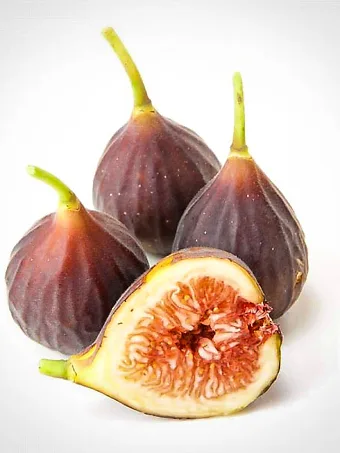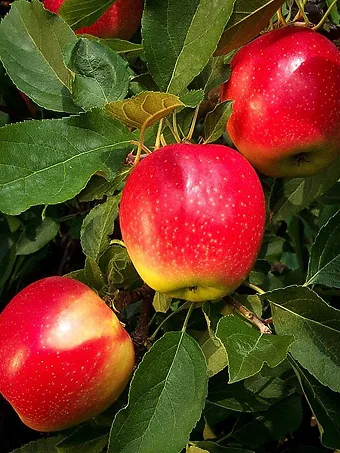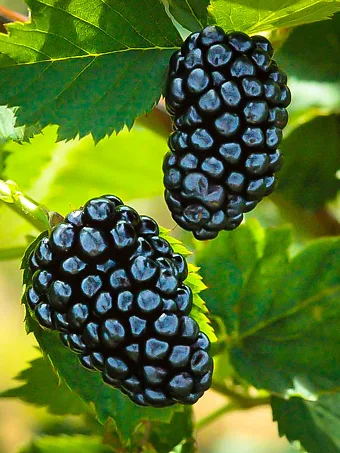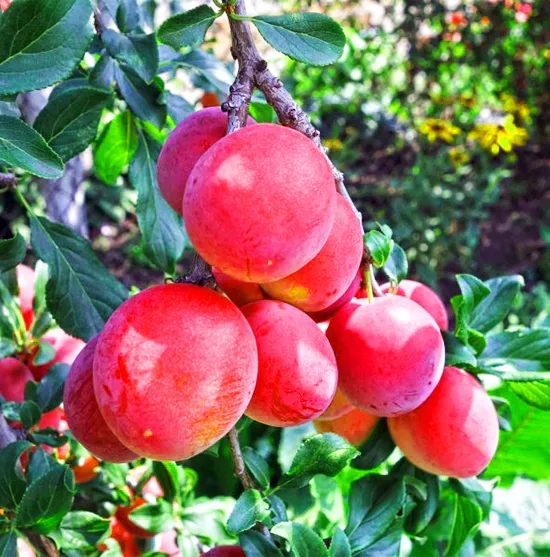
Bruce Plum Tree
Prunus salicina x angustifolia 'Bruce'View more from Plum Trees
Bruce Plum Tree
Prunus salicina x angustifolia 'Bruce'
Select Size
30 day - ARRIVE AND THRIVE™ guaranteeLearn more


Special Features

Botanical Name
Prunus salicina x angustifolia 'Bruce'
Outdoor Growing zone
5-9
Mature Height
10-20
Mature Width
12-15
Sun needs
Full Sun
The Bruce Plum Tree is a popular classic variety of plum developed for the west and south, where hot dry summers come early and can shrivel late-ripening fruit crops. It is ready for harvest by mid-June, or even earlier, and it doesn’t need a lot of winter chill to bloom well. The big plums have a bright red skin and red-orange flesh that is tasty, with a perfect balance of sweet and tart. It is ideal for eating fresh, but also for baking and preserves. This fast-growing tree will be giving you big crops within just a few years.
- Reliable crop of delicious red-skinned and orange fleshed plums
- Harvest in June for an early crop
- Ideal tree for areas with hot, dry summers
- Excellent fresh and for baking and preserves as well
- Big harvest every year because bloom time avoids spring frosts
The Bruce Plum Tree should be planted in full sun for a good crop, and it grows in any well-drained soil, including alkaline soils and sandy soils as well. It has good disease resistance, and pests are rarely serious. No complex pruning is needed – just shorten back long shoots – and it soon reaches full size. Plant a second similar variety for cross-pollination, such as ‘Morris’, ‘Burbank’ or ‘Methley’.
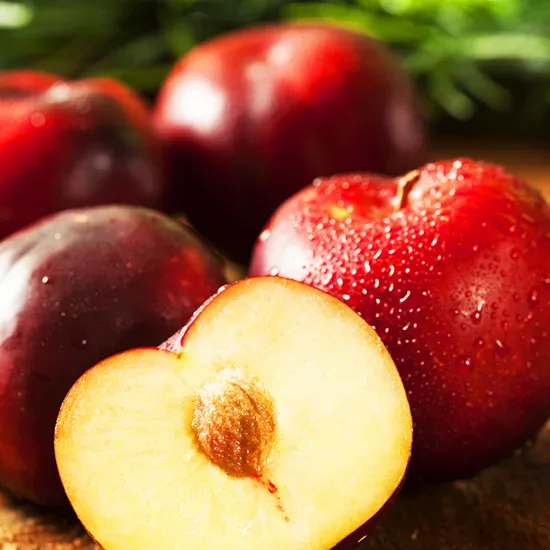
Plums are among the most useful and versatile of all fruits, especially if you like pies and preserves. Trees grow rapidly, so within a few years you are harvesting big crops and stocking your shelves with great home-grown edibles. In areas with hot, dry summers it pays to plant early ripening varieties that are ready before the summer heat and drought shrivels a developing crop – and it also pays to plant a hybrid variety that is tougher and more adaptable to local conditions. That’s where the Bruce Plum Tree steps forward, ready to take on heat and humidity, as well as the occasional late spring frost. The big red plums are delicious fresh and just as delicious for baking or jam-making. The perfect choice for the dry West and the humid southeast as well, if heat is a big factor in your garden, then the Bruce Plum Tree is the tree for you.
Growing the Bruce Plum Tree
Size and Appearance
A fast-growing deciduous tree, the Bruce Plum Tree will be pushing over 10 feet tall within a few years, and could reach 20 feet tall and 15 feet wide within a decade or so. The glossy green leaves make it attractive enough to be a shade tree in a small garden, and the charming white flowers, carried on bare branches in spring, make a very pretty show, full of promise of the bumper crop to come. Blooms come a little later than on some other plum trees, helping it escape from late spring frosts which can damage the prospects of a harvest. Consequently this is a reliable tree that sets a big crop every year. This variety will only set a few fruits without another suitable plum nearby, as it is not self-fertile. We recommend you plant a second suitable plum tree nearby, such as ‘Morris’, ‘Burbank’, or ‘Methley’. If you only have room for one plum tree in your garden, check out the Au Rosa Plum, a compact self-fertile variety that give a great crop.
The plums grow and develop fast, ripening by mid-June, before the really hot and dry weather arrives. So spring and early summer rains plump them up, giving you a large 2-inch plum with bright red to orange skin and orange-yellow flesh, and a delicious sweet yet tangy flavor. The flesh is yielding, so it’s great for eating fresh, but it also cooks beautifully into cakes and pies, as well as making delicious jam.
Using the Bruce Plum Tree in Your Garden
Urban gardening is the big thing today, and the Bruce Plum Tree is great for that, because it’s tough and reliable, needs little attention and sets a big crop every year. Grow it out on a lawn as a specimen, or, instead of a boring hedge, grow a line of fruit trees – edible hedge anyone? It is also useful at the back of your shrub beds, or of course in a dedicated orchard area.
Hardiness
The Bruce Plum Tree only needs 500 chilling hours over winter – that’s time when the temperature is below 45 degrees. So that means that throughout Georgia, and everywhere north of the Gulf coast and Florida, you can grow this tree easily. Yet it is also hardy in zone 5, so don’t worry, just plant it.
Sun Exposure and Soil Conditions
Full sun is needed for good blooming and for fruit ripening, but beyond that pretty much anything goes. Almost all well-drained soils are suitable for the Bruce Plum Tree, including more sandy soils as well as heavier ground and even urban conditions. Plums are among the easiest fruit trees to grow, and a great way to start an orchard.
Maintenance and Pruning
From the moment the Bruce Plum Tree was developed it was obvious that this was a variety with excellent resistance to diseases. Any bugs or pests will be easy to control with soap spray or neem oil spray – both harmless to you and your family. Complex pruning isn’t needed with this tree, so it’s a great tree to get started with fruit growing. Just remove a few branches to keep it from getting overcrowded, and shorten back side shoots longer than 12 inches to encourage more blooms. Prune in late winter or in summer after harvesting the last plums.
History and Origin of the Bruce Plum Tree
Luther Burbank was one of the world’s greatest fruit breeders, and he introduced many new plants into America towards the end of the 19th century, and bred many more. When it was found that the European plum brought over by the early settlers didn’t grow so well in the West, he brought the Japanese plum, Prunus salicina, over from Japan, although that tree actually originated in China. It was one of the original seedlings he brought over in 1888, christened ‘Abundance’, that is the prime parent of the Bruce Plum Tree. We don’t know exactly who A. L. Bruce of Donley, Texas was, but in the 1920s he crossed ‘Abundance’ with the wild Chickasaw plum, Prunus angustifolia. That plant grows wild across most of southeastern and central America, down into Florida and across to Texas, and was eaten by native Americans. Among the seedlings of this cross was one that caught his eye, and that was released in 1929 as ‘Bruce’, becoming a popular plum for home growers as well as commercial farmers.
Buying the Bruce Plum Tree at the Tree Center
If ‘hot, dry summer’ sounds like you, then the Bruce Plum Tree sounds like your kind of tree. Imagine pulling out a jar of your own jam in the depths of winter, and tasting all that summer goodness you grew so easily. But order now, as this popular variety is always in high demand, and our stocks soon sell out.
